Here’s all about the shelf life and spoilage of parmesan cheese. Learn how long parmesan lasts and what are the spoilage signs.
Got some leftover parm that’s been sitting in the fridge for a few weeks already? If so, you’re probably wondering how long parmesan lasts after opening.
Or maybe yours is a bit iffy, and you’d like to make sure it’s safe to eat. In that case, you need to know how to tell if parmesan is bad.
Sounds familiar?
If so, you’re in the right spot. Let’s jump right in.
In this article, I cover Parmigiano Reggiano, the “original” Parmesan from Italy. In the US, the name Parmesan is sometimes used to describe similar cheeses, not the one from Italy, but they all share similar characteristics.
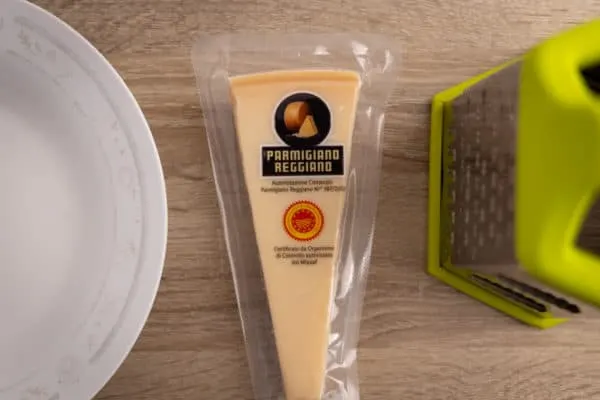
Table of Contents
- Does Parmesan Cheese Go Bad?
- How Long Does Parmesan Cheese Last?
- How to Tell if Parmesan Is Bad?
- How to Store Parmesan Cheese?
- Can You Freeze Parmesan Cheese?
Does Parmesan Cheese Go Bad?
Parmesan cheese eventually goes bad, no matter if it’s sold as a block, wedge, or grated. As a hard cheese with a relatively low moisture level, parmesan keeps for much longer than soft cheeses, but it won’t last forever.
Sooner or later, the cheese will either dry out to a point the quality is no longer acceptable or start to grow mold. That might take a few months after unwrapping the wedge, but it will happen nonetheless.
And if you’re working with grated parmesan, it will happen much sooner unless you freeze the leftovers after opening.
With that in mind, let’s talk about the shelf life of parmesan.
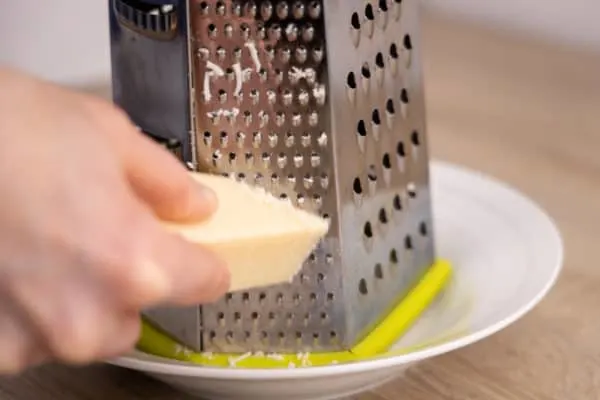
How Long Does Parmesan Cheese Last?
An unopened wedge of parmesan cheese usually lasts between 7 to 9 months, sometimes a bit longer. After opening, parmesan keeps great quality for one to two months if tightly wrapped and refrigerated, but can last even longer.
If those few months after unwrapping aren’t long enough, you can grate or shred the cheese and freeze it.
As you can tell, parmesan lasts quite a while, at least compared to soft cheeses like ricotta or cream cheese.
Once opened, parmesan doesn’t go bad that quickly or easily. If you wrap it well and it doesn’t have access to fresh air, it can still last for a few months without being frozen. That’s thanks to its low moisture content (common for all hard cheeses) that discourages mold growth.
Of course, parmesan can still grow mold. Try placing it unwrapped near half-open blue cheese for a few days to find out.
That said, neither unopened nor open parmesan keep quality forever. The cheese gradually deteriorates, so while it might still be safe to use if it’s a few months beyond the printed date or 3+ months after opening, the quality may be pretty bad.
In other words, if there aren’t any typical spoilage signs, you still need to assess the quality before using the cheese.
(We’ll cover spoilage signs in a moment.)
For now, let’s talk about grated parm.
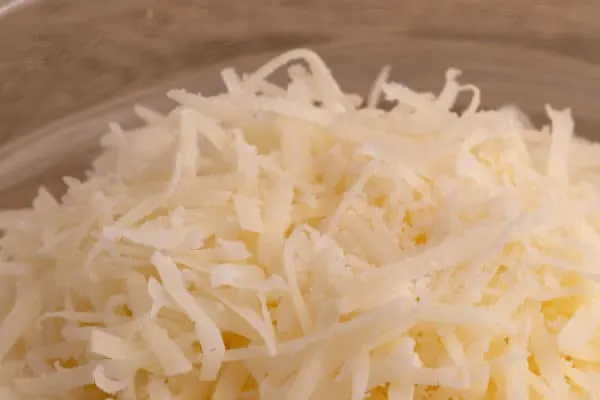
Shredded or Grated Parmesan
An unopened package of grated or shredded parmesan usually keeps for at least a few weeks beyond the printed date. Once opened, you should use it within 4 to 5 days or freeze the leftovers.
Grated parmesan dries out quickly, hence the short storage time. That means you should use it as soon as possible.
Fortunately, grated and shredded parm freeze well, so you can just chuck the leftovers (tightly sealed) in the freezer and use when needed. No need to force yourself to use the whole bag within a few days.
(Unless you want to, of course.)
Having covered that, let’s talk about the signs of spoilage.
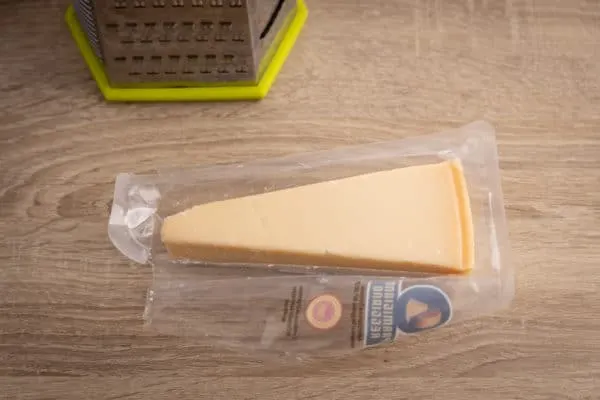
How to Tell if Parmesan Is Bad?
Your parmesan is bad if it’s moldy, smells moldy or sour, takes on a weird shade of dark yellow or gray, or its flavor changes. You should also toss it if it’s completely dried and starts to crumble by itself.
Parmesan is a hard cheese, so you can cut away small bits of mold and use the rest. Make sure you cut off at least 1 inch around the fuzzy spot, and don’t touch the mold with your knife. Otherwise, you’ll cross-contaminate another area, and it’ll be moldy in no time.
Of course, if mold covers a large area, like a third of the cheese, it’s game over for the wedge.
Next, examine the general color of the cheese. If the body has turned dark yellow or even grey, it’s obvious the parm is no longer safe to eat.
When it comes to smell, things are simple. If the cheese emits sour, moldy, or pungent odors, throw it in the trash.
If everything up to this point seems okay, it’s time to check its texture and taste it.
As mentioned, if your parmesan is dried out and super crumbly, you should probably toss it for quality reasons. But if it’s firm and tastes good, it’s most likely okay to use.
If the parm you grated is a bit dry, that’s okay. It should still do quite fine if you melt it.
Finally, let’s talk about two things that throw people off: parmesan’s rind and white crystals on the surface.

Rind
Parmesan’s rind is different in color (yellow or orange-ish) and often quite hard. That’s normal, and there’s nothing wrong with the cheese.
The rind is too firm for salads and similar uses, but you can grate it and use it for melting. Alternatively, you can throw it into almost any soup for extra flavor.
White Crystals
Small whitish crystals on the surface and inside of parmesan are not mold. These are known as cheese crystals and form naturally. If anything, they are a good sign the cheese is mature.
How do you tell if the white thing you see on the surface is mold or cheese crystals?
Mold is fuzzy, while cheese crystals are semi-solid to solid granules. Plus, cheese crystals typically appear in many places all at once (as they are a product of the cheese drying out), while mold shows up as single fuzzy spots.
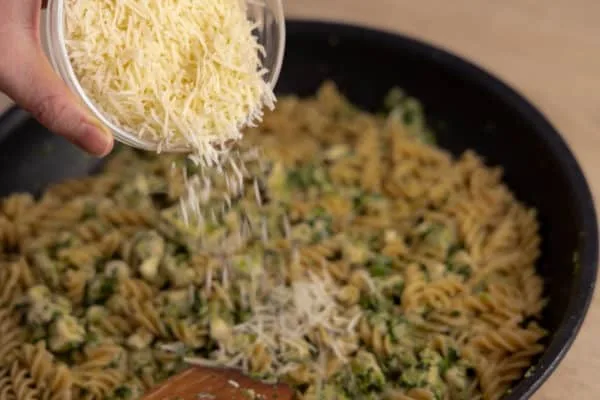
How to Store Parmesan Cheese?
The best way to store grated cheese and Parmesan blocks is by keeping them in the refrigerator. Parmesan wedges or blocks should have their rind.
Keep the storage temperature between 39 to 46 degrees Fahrenheit for best results.
For parmesan blocks, we recommend covering the product in cling wrap or aluminum foil before storing the cheese in the fridge. The extra protection will keep fridge odors away. The wrapper will also inhibit moisture loss so the cheese won’t dry out too much while in storage.
Alternatively, you can put the wedge in a freezer bag or an airtight container.

Grated parmesan cheese doesn’t require any prep at all. Just stick the container in the fridge, and you’re done. And if you grate it yourself, transfer everything into a resealable container or freezer bag, and refrigerate.
Can You Freeze Parmesan Cheese?
Freezing is usually not necessary because parmesan cheese has a long shelf life.
But if you must, you can freeze the cheese. However, the freezing temperature could decrease the quality of the cheese. The parmesan cheese could lose its original texture (crumbliness) and a bit of flavor as soon as it is thawed.
Frozen parmesan cheese is best used for cooking sauces, soups, and casseroles.

The best way to freeze parmesan is to freeze it grated. This way, it’s ready to use right away, without thawing.
The how-to is simple:
- Grate the leftover parm.
- Transfer it to an airtight container or freezer bag.
- Freeze.
The grated cheese shouldn’t stick much (don’t try to compress is, though) so you should be able to grab a pinch (or ten) whenever you need some. Just take the container out of the freezer, take as much parmesan as you need, and return the rest.
If you’d like to learn more about this topic, I wrote a whole guide to freezing parmesan on my sister site canyoufreezethis.com.